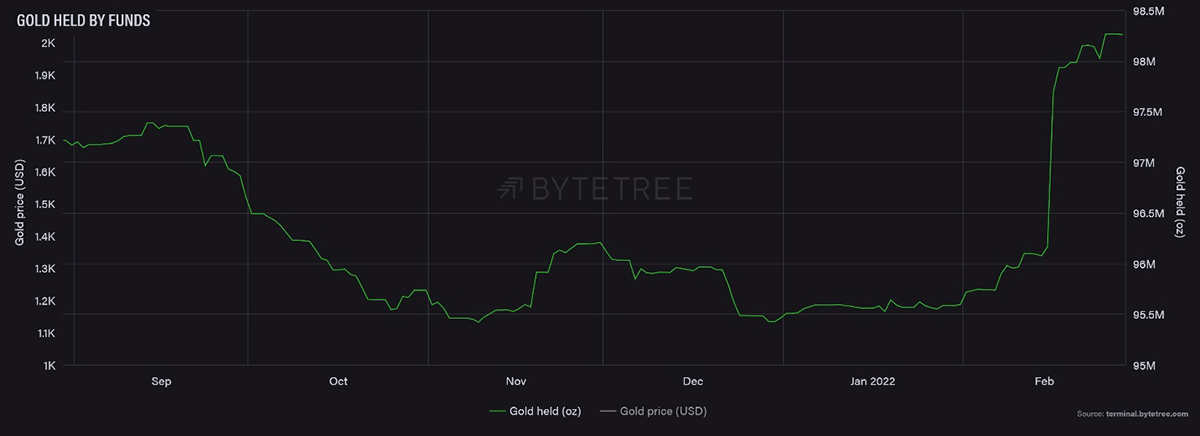Entering a Golden Age: Examining the Case for Gold in a Changed World

Disclaimer: Your capital is at risk. This is not investment advice.
Webinar with John Reade, Chief Market Strategist, World Gold Council
The title is deliberately ambiguous. It is a sad irony that the time for gold to demonstrate its prowess typically coincides with turbulent economic and political conditions.
Gold has returned to the investment conversation. Even before Russia shattered 75 years of peace in Europe* by invading Ukraine, for the first time since the early 1990s, we are confronted with levels of inflation that are highly problematic. Debt levels across the western hemisphere are correspondingly at eye-watering high levels, leaving policy makers with little wriggle room to bring prices under control without triggering a collapse. This is not a strong backdrop for equities and bonds.
In our latest “Bitcoin & Gold in 2022” webinar, John Reade, Chief Market Strategist of the World Gold Council (WGC), estimated that while more than 50% of institutional investors have exposure to gold in some shape or form (via equities/commodity indices etc), less than 10% have it as a strategic portfolio allocation. In other words, less than 10% of investment institutions own it for its core qualities of protecting against inflation and political crisis. Yet these are precisely the circumstances that stare us in the face today.
Why are exposures so low? One answer lies in what might be termed “institutional memory”. It is 75 years since the end of the Second World War, arguably the last major country vs country military conflict in Europe until last week, and it is 30 years since inflation last sustainably held at over 5%. Generations of investors are simply unable to contemplate disruption on the scale that we are now witnessing and won’t have had any need to allocate capital beyond the sunny uplands of equities and bonds. Gold’s properties as a portfolio diversifier have been institutionally forgotten by those who have spent a lifetime confusing the declining cost of money with investment genius. Not least because there’s no one around to make its case (except for the WGC), unlike the multi-billion-dollar equity and debt intermediaries which are highly incentivized to promote share and bond-holder culture.
John articulated three key reasons to embrace gold:
- It does well in times of inflation and crisis
- Returns over the longer term are in line with or better than other asset classes – it’s not just for the rainy days, it’s for all the time
- It’s a great diversifier of portfolios, because:
a. It’s generally uncorrelated to equities
b. It’s negatively correlated when other assets are falling fast, exactly what you want.
The second point - that the “barbarous relic” is not just for rainy days - is much more striking than the first, which we all suspect anyway. Gold has been a good investment over a 30-year period, supposedly not conducive to its success. Apart from aberrations in 2011, the last sustained period of UK monthly inflation above 5% ended in March 1992. Since then, gold has risen 560%, while the FTSE100 has risen 290%. If you were told you had 30 years of low inflation in front of you, would that have been your bet in March 1992?
On the subject of portfolio diversification, the WGC has done a ton of work looking at the impact of different allocations in a balanced portfolio. As he says:
“in every case they have looked at around the world, adding a small component of gold - somewhere between 4 and maybe 10%, depending on the country and benchmarks… increases the risk-adjusted return of that portfolio.”
If gold can do so well in a macro environment that doesn’t suit it, what are its prospects in an environment that does? That’s a rhetorical question. Whatever the answer, it appears that investors are starting to hedge their bets, as shown by flows into gold funds over the last couple of weeks.

The smartest investors don’t pretend to know whether or not inflation will be at a certain level by the end of the year, nor do they pretend to know whether wars will endure or cease. They might make a call on the likelihood of those events, and that informs allocation. Diversification is a way of insuring a portfolio in case these things happen. You insure your house; why not your life savings?
Whatever your judgement on the outlook for inflation and political crises, it seems imprudent to position yourself for neither. Recent inflation trends, not to mention the price of oil, combined with the conflict in Ukraine, mark regime change on both the economic and political front. This is a momentous time. Markets are like supertankers and take much longer than people think to reflect a new era and we are just at the start of this one. This is reflected in Central Bank attitudes to gold, which, according to John, have recently turned net buyers (and not only in the developing world).
What are the risks to holding gold? It might underperform other asset classes, but that’s not really the point. We discussed confiscation, which is seen as highly unlikely due to its modern-day unimportance and lack of connection to the existing financial system, not to mention the fact that there are much easier things to confiscate. We also discussed bitcoin, which positions itself as “digital gold” and which John is frequently asked about.
The WGC has done a lot of work surveying people about their attitudes to gold and bitcoin, all of which lend support to ByteTree’s conviction that the two assets are complementary. In general, people don’t (yet) think of bitcoin as a store of value – it is more widely seen as a way to get rich. Conversely, gold owners don’t think about ownership of gold as the keys to a Lambo. There are obvious similarities in supply dynamics, non-sovereignty and the fact that neither has any inherent credit risk, but huge differences in transferability, brand recognition, acceptance, demographic ownership and pedigree. As John says, quoting Charlie Morris, “One makes you rich, one keeps you rich”**.
Our belief is that hard assets such as gold and bitcoin are going to be vital components of investment portfolios for many years to come. Yet most professional investors know, care and understand little about either. Gold is often seen as old-school, good only for jewellery and electronic parts, while bitcoin is new, speculative and volatile. The WGC is doing a great service in educating investors about gold’s role as an investment, and its website is a rich source of analysis and research. Meanwhile, bitcoin, which now trades only a fraction below its level at the start of the year, is doing its best to assert its credentials as gold’s new best friend.
**This is the premise behind the ByteTree BOLD Index, which blends together bitcoin and gold in a way that adjusts for the riskiness of each asset. Details can be found here. Sign up to be kept in touch with news on products relating to BOLD.
*You can nitpick here, I’m not including conflicts relating to the end of the Soviet Union, such as the civil war in Bosnia, or separatist conflicts.
